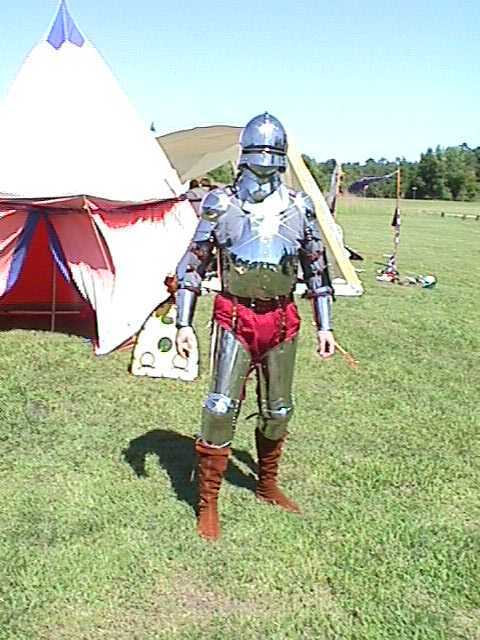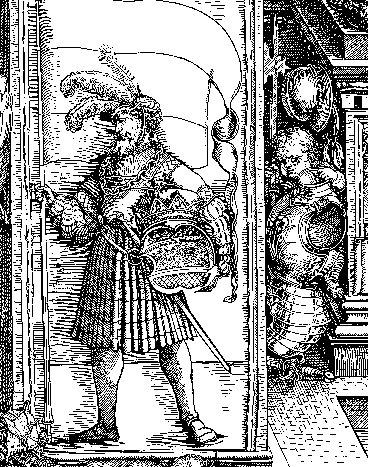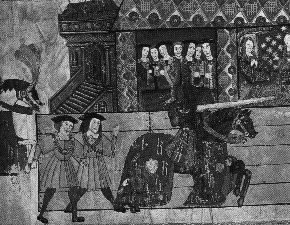An Early 16th century
armour adaptation for the SCA.

The early 16th century was a time a great conflict
in Western Europe. Nations were being formed and Empires founded.
Many developments were made in the craft of armour but at the same time
armour was being abandoned by some troop types. There was a greater
variety of troop types and armour needs.
Many of the armour styles from the late 15th century were still
in use into the first few decades of the century but there were styles
in development that were very different. Often these became blended
into the common style of the time.
Sallets were still widely used by both infantry and cavalry units.
Many of the styles where the same as they were in the late 15th century.
There were some unique to the 16th century but it is not necessary that
someone should get one of these for a 16th century suit. A wide variety
of kettle hats were worn by infantry as well. Burgonets were also
appearing in the early century as an infantry and light cavalry helm.
Armets were still used by fully armored cavalry and heavily armour foot
troops in 3/4 suits and the Closed Helm started to appear. The great
Bascinet did not however make the transition into the new century in any
number.
There was a wide variety of body armour in use. While the
latest developments in plate had replaced the horizontally segmented breastplate
of the late 15th century with a solid globous shaped breastplate the old
style continued to be used especially in Germany. Brigandines and
covered breastplates were also still in use but the covered breastplates
followed the pattern of the newer armour developments. Brigandines
were very similar to those used in the 15th century.
Leg armour was far less common especially among infantry.
What leg armour there was rarely went down pas the knee. The legs
were often protected by long tassets that sometimes ended in knee armour
but sometimes stopped just above the knee. Some plate leg armour
was in use and much of it was similar to that used in the late 15th century.
Arms defense was also less common among the infantry and light
cavalry but some forms did exist. The German style floating elbow
was very common among the infantry as were simple pauldrons and shovel
vambraces and rebraces that only covered half the arm. Fully articulated
arms were used but the elbow had changed from the conical style of the
late 15th century to a domed style. When gauntlets were worn they
were most often mitten gauntlets. Finger gauntlets seem to have become
very uncommon at the time perhaps due to the increased mixing of halbards
and greatswords into pike formations.
A great variety of fashion was worn with and over armour.
Swiss and German styles were the most popular through out Europe.
These styles were baggier in general than those of the late 15th century
and were often worn over the armour. The clothing was often heavily
slashed letting the under garments and or the armour beneath it to show
through. This style became so universal that often the only way to differentiate
between Swiss and German solders is by the type of slashed crosses in their
garments. The Swiss slashed a Swiss cross, +, and the Germans a Burgundian
saltier cross, X. A slightly baggy knee length over hose where often
work on the legs and were often heavily slashed.
As far as adapting early 16th century armour and military fashion
to SCA combat goes it is both one that requires little hard plate armour
but the plate that is needed is usually very expensive. Helmet and
gauntlets are all that are really required for early 16th century armour
however you can include much more plate if you like. There were a
number of garments worn over upper body armour that hide most if not all
of it so one can achieve a fairly armored look by only adding plate legs
to the required Helmet and gauntlets. A very low profile set of arms
and body defenses can be constructed out of whatever materials suit you
as many of the fashions. As far as leg defenses go I have seen some
very convincing early 16th century leg defenses made in much the same manner
as a gamboised leg defense covered with some slashed knee length hose.
Also a set of simple knee cops minus fans can be attached to leather or
plastic upper legs armour and hidden under a pair of slightly baggy outer
hose.
The above drawing is one I did for Michael who sent me the photo
below of his existing gear. He wanted something that would work well
for the early 16th century. He plans to add more plate but wants
some period looking for the interim. This was a quite simple adaptation.
I have chosen to give his a look similar to a light cavalry trooper.
The Surcoat is similar to the one in the Albrecht Durer wood cut below
and the ones worn by the attendants in the illumination below of a joust
Henery VIII took part in. While both of these show an un pleated
sleeve I have chosen to show a pleated one I have come across of several
occasions for a bit of variety. The boots are a round toed riding
boots with the tops turned down. The were most popular in the late
15th century for light cavalry but still used in the first decade or so
of the 16th century by the same kind of troopers. While a lot of
plate is shown it could easily be replaced by simpler defenses hidden by
clothing similar to the baggy armed garment in the Durer wood cut and the
slightly baggy pants in the wood cut of an early 16th century German greatswordsman.
 Michael's armour as it is now.
Michael's armour as it is now.

 An early Albrecht Durer Wood cut from about 1515.
An early 16th century german
An early Albrecht Durer Wood cut from about 1515.
An early 16th century german
 A detail of a painting of a Joust Henery VIII participated in.
Note the surcoats worn by the attendants.
A detail of a painting of a Joust Henery VIII participated in.
Note the surcoats worn by the attendants.
More drawings to come on this one.





